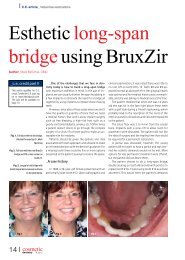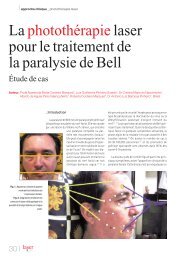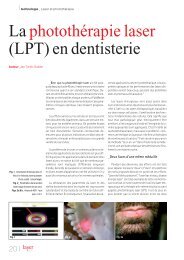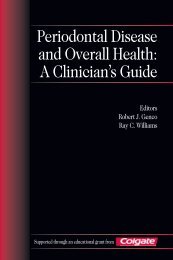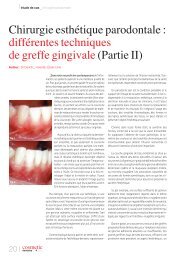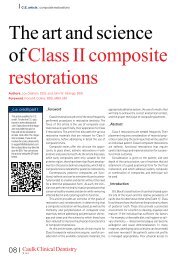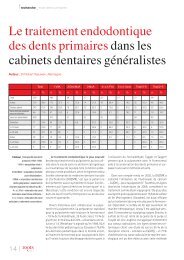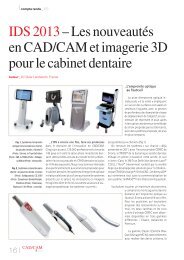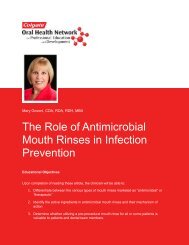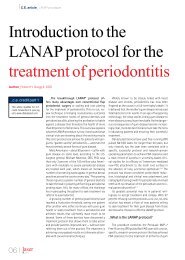Periodontal Disease and Overall Health: A Clinician's Guide
Periodontal Disease and Overall Health: A Clinician's Guide
Periodontal Disease and Overall Health: A Clinician's Guide
Create successful ePaper yourself
Turn your PDF publications into a flip-book with our unique Google optimized e-Paper software.
50 <strong>Periodontal</strong> <strong>Disease</strong> <strong>and</strong> <strong>Overall</strong> <strong>Health</strong>: A <strong>Clinician's</strong> <strong>Guide</strong>gender (with more disease seen in males),hereditary factors, infection with periodontalpatho gens, cigarette smoking, <strong>and</strong> diabetes.It should be noted that these are risk factorscom mon to many chronic, noncommunicablediseases, such as heart disease, stroke,<strong>and</strong> diabetes, all of which are associated withperiodontitis. 39Periodontitis/Oral <strong>Health</strong>as a Risk for Specific <strong>Disease</strong>s:Evidence for an AssociationCardiovascularThere are at least three possible mechanismsby which oral infections may contributeto cardiovascular disease: 401. Direct effect of infectious agent inatheroma formation2. Indirect or host-mediated responses3. Common genetic predispositionBahekar 35 <strong>and</strong> colleagues recently conducteda systematic review of the literaturein order to evaluate if such an association exists.This review revealed five prospectivecohort studies involving 86,092 patients forat least six years. The authors consideredthat three out of the five prospective studieswere of good quality, <strong>and</strong> both the incidence<strong>and</strong> prevalence of coronary heart diseasewere increased in subjects with periodontaldisease after adjustments for other variablesknown to increase the risk of coronary heartdisease. Furthermore, five case-control studiesinvolving 1,423 patients <strong>and</strong> five crosssectionalstudies involving 17,724 patientswere also evaluated. All supported a sig -nificant relationship between periodontaldisease <strong>and</strong> coronary heart disease. Moreprospective studies are needed, however, toprove the assumption that periodontitis maybe a risk factor for coronary heart disease <strong>and</strong>to evaluate risk reduction with the treatmentof periodontitis.In planning prospective studies, it isimportant to remember that patients with periodontaldisease share many of the samerisk factors as patients with cardiovasculardisease. These risk factors include age, gender,lower socioeconomic status, stress, <strong>and</strong>smoking. 41 Additionally, a large number ofpatients with periodontal disease also exhibitcardiovascular disease; this could bean indication that periodontal disease <strong>and</strong>atherosclerosis share similar or common etiologicpathways. 42 The literature also suggeststhat a number of pathogens, antigens,endotoxins, <strong>and</strong> cytokines of periodontitismight be significant contributing factors. 43,44According to Williams et al., 45 controlling forsuch confounding factors when carrying outepidemiological <strong>and</strong> observational studies requireslarge numbers of subjects to be enrolled<strong>and</strong> these subjects need to be followedover a long period of time. Common perio -don tal pathogens such as Porphyromonas gingi -valis <strong>and</strong> Streptococcus sanguis have been foundin arterial plaques from carotid en darterec tomysamples. Furthermore, perio dontal disease hasbeen associated with elevated levels of inflammatorymarkers, such as C-reactive protein.Although there is growing evidence tosupport a role for C-reactive protein as a predictive,pathogenic factor for vascular risk, itis recognized that more research is needed. 35There is a need for large-scale prospectiveintervention studies to assess whether ornot periodontitis can be considered an effec -tive modifiable risk factor in the prevention ofcardiovascular disease.Adverse Pregnancy OutcomesSeveral studies on laboratory animals thattook place in the 1970s <strong>and</strong> 1980s re vealedthat bacterial endotoxin (a cell wall com ponentisolated from E. coli) is capable of pro ducingspontaneous abortion, low fetal weight, <strong>and</strong>malformations. 46 Collins <strong>and</strong> col leagues suc -cessfully demonstrated that oral anaerobessuch as P. gingivalis had similar effects. 47,48In 1996, Offenbacher <strong>and</strong> colleaguesconstructed a case-control study with thetitle “<strong>Periodontal</strong> Infection as a Possible Risk



